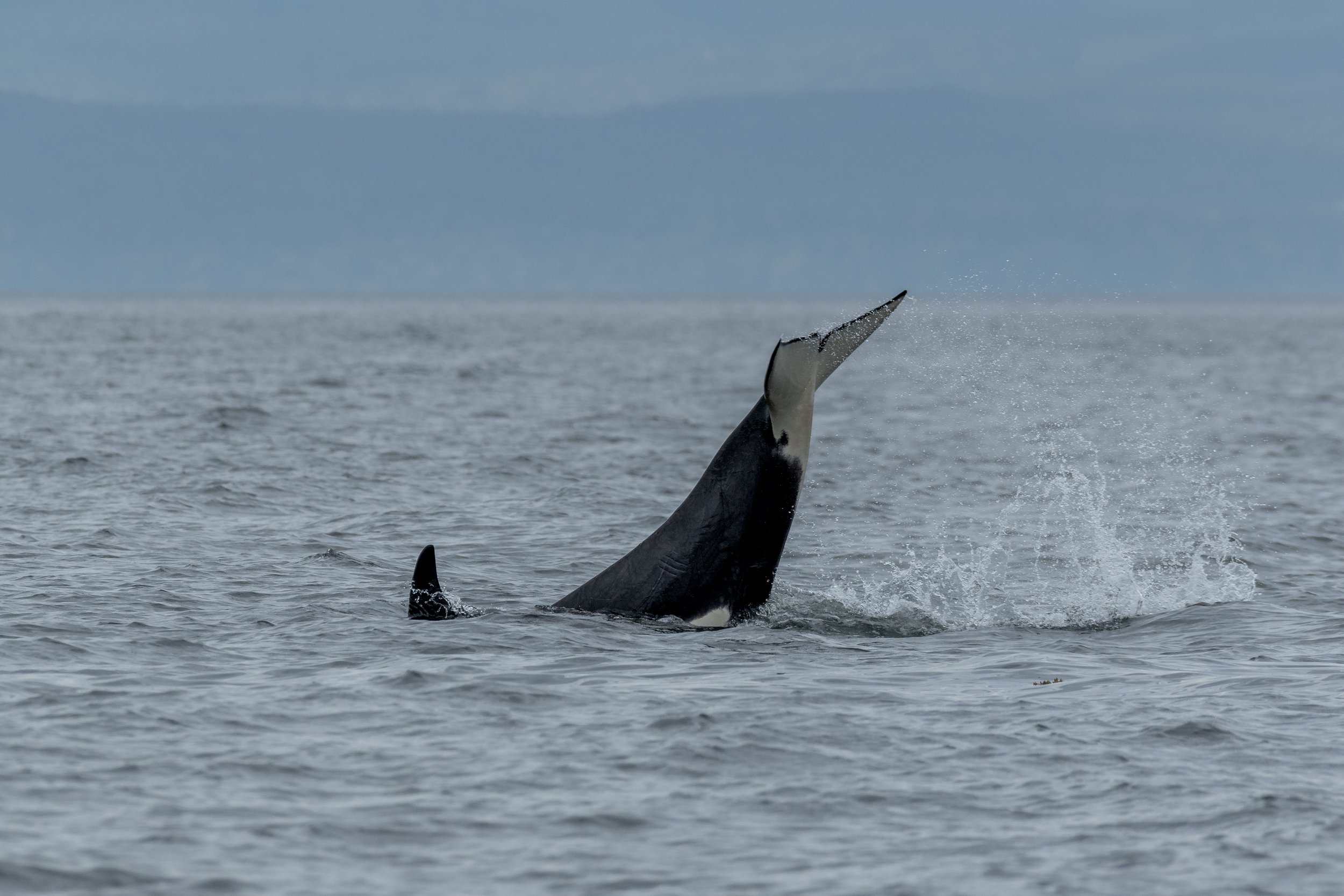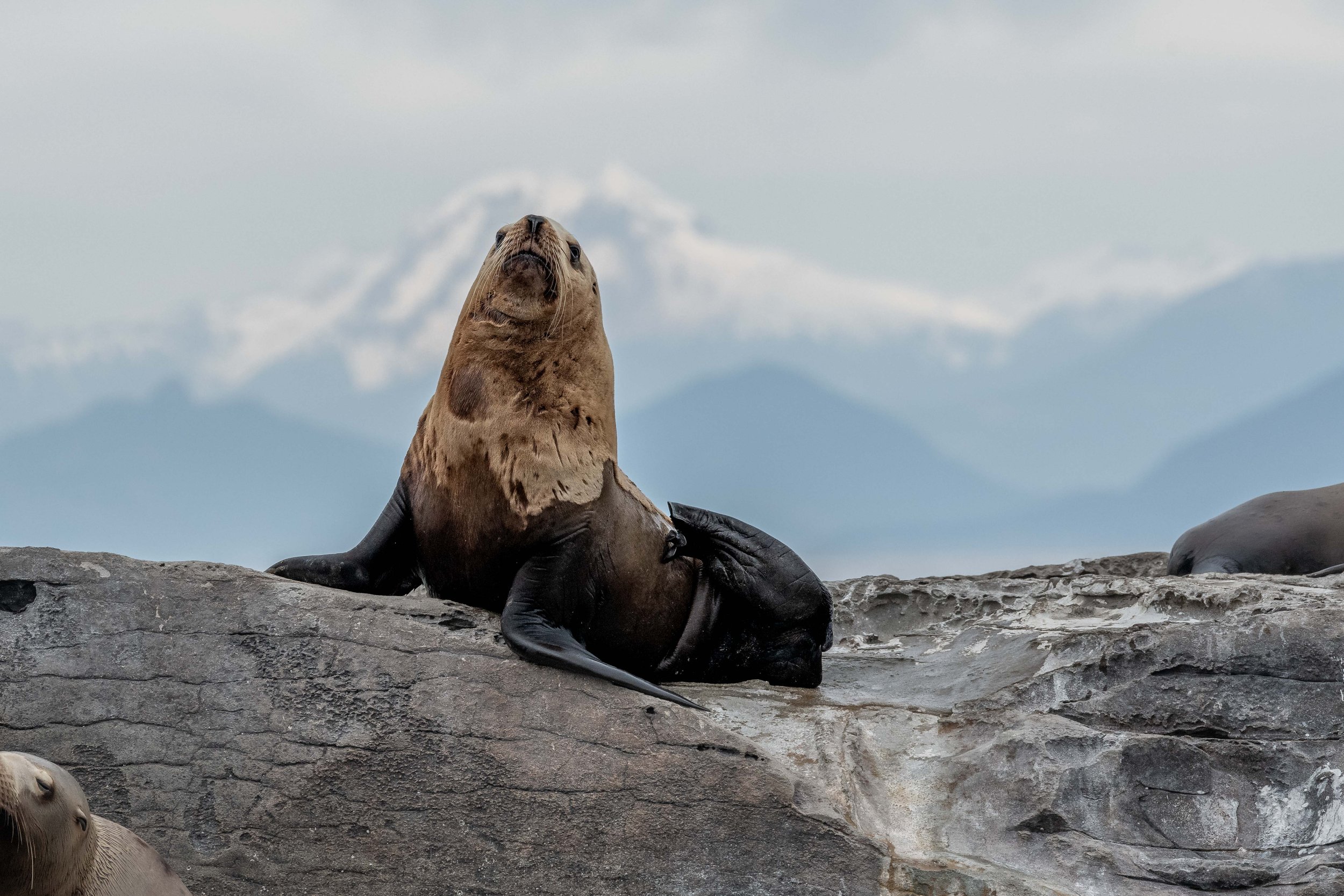April 20, 2024 - The T065Bs commit a Murreder by Entrance Island
We didn’t need to go far to find whales today! After receiving a nice and early report of orca close to Gabriola Island, we eagerly dashed off the dock and turned towards Entrance Island. After a few minutes, we found them! These 4 were identified as the T065Bs:
T065B Chunk ♀ (1993)
T065B1 Birdsall ♂ (2011)
T065B2 Nettle/Corvus ♂ (2019)
T065B3 ♂ (2023)
These four were travelling close together, with the youngest member of the pod rolling around amongst his family members. Orca are very social and tactile creatures so seeing them play around isn’t too uncommon. However, what happened after their playful antics is a bit less common!
The two youngest members of the pod, T065B2 Nettle/Corvus and T065B3, suddenly seemed very interested in a bird paddling on the surface of the water. In the blink of an eye, the two suddenly started porpoising (travelling above the water at speed) and they quickly took down a Murre together!
While birds are not a staple in their diet, hunting birds is a great way for young orca to practice their skills. Young whales such as T065B3 learn the importance of stealth and speed when they practice on smaller prey.
After making our way away from the T065Bs we continued our journey in search of other wildlife. We stopped in at an area lovingly referred to as “Stinky Rocks” - a series of rocky outcroppings that our Sea lions love to haul out on. There were many large, grumbly sea lions perched up on the rocks enjoying the weather. We even spotted a nursing pup amongst the adults! While most pups are weaned by 1 year old, they can continue nursing until they are around 3 years old.
Besides the sea lions, we also saw a couple of Harbour seals balancing on the rocks. These seals were “banana posing”, or keeping their heads and hind flippers out of the water. It is believed they do this to thermoregulate (control their internal temperature).
Once we departed our pinnipeds we took one last stop to see some birds at the Gabriola Bluffs. Our Cormorants are busily preparing their nesting areas in anticipation of the nesting season. We also saw a couple of Bald Eagles perched nearby - one in a tree, and one on top of a pile of shavings.
Overall it was another fantastic day out on the water with some amazing action from our orca!
Photos taken by Marine Naturalist Aly Kohlman.
T065B Chunk, T065B3 (rolling), and T065B1 Birdsall.
T065B2 Nettle/Corvus’s dorsal fin.
Just before the hunt began…
The hunt begins!
Look at that incredible surface tension from T065B3!
T065B Chunk with her eldest son T065B1 Birdsall.
Orca belly!
You can just barely see the tip of the Murre at the front of T065B3’s mouth.
Nose-to-nose.
T065B1 Birdsall with his distinct highly scarred saddle patch.
T065B3 is also starting to get some wicked scars!
Rolling as he dives.
You can see just the faintest red below the water as the Murre was gobbled up.
T065B Chunk. Do you see how she got her name?
T065B1 Birdsall travelling with his brother T065B2 Nettle/Corvus.
T065B2 Nettle/Corvus and his brother T065B3.
Flukes up!
T065B3 with his eyepatch visible above the water.
There was a lot of excitement amongst the two youngest pod members after they completed their Murre hunt.
T065B2 Nettle/Corvus beside their big brother T065B1 Birdsall.
If you look closely, you can see rake marks (deep indentations) along T065B3’s spine.
Left to right: T065B3, T065B1 Birdsall, and T065B Chunk.
T065B1 Birdsall showing off his battle scars!
A raft of sea lions.
Scratching that itch.
It is rarely calm at our sea lion haul outs!
A suckling sea lion on the rocks.
This large male Steller sea lion looked so fuzzy and cozy!
A trio of Harbour seals banana posing.
An unusual perch for a Bald Eagle, but it works!
A much more normal perch for a Bald Eagle!
Cormorants hard at work building and fortifying their nests.
































